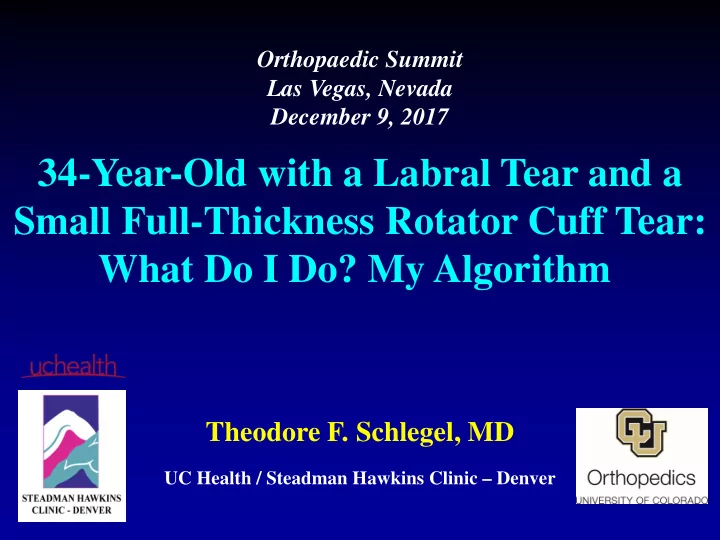

Orthopaedic Summit Las Vegas, Nevada December 9, 2017 34-Year-Old with a Labral Tear and a Small Full-Thickness Rotator Cuff Tear: What Do I Do? My Algorithm Theodore F. Schlegel, MD UC Health / Steadman Hawkins Clinic – Denver
Disclosures Neither I, Theodore Schlegel, or a family member have relevant financial relationships to be discussed, directly or indirectly, referred to or illustrated with or without recognition within the presentation as follows: Available in the course book and on the AAOS website
Who came up with this title? This combination rarely occurs
Case to Consider 34 year old RHD professional kiteboarder who presents following an acute traumatic traction injury to his RUE Plus small full thickness cuff tear Labral Tear Did this combination occur as a result of a traumatic instability incident?
Define the Condition So say we really do see one of these patients, then we need to figure out if: 1) Is it is a rotator cuff tear w/o instability and labral tear (SLAP) or is it 2) Is it a rotator cuff tear with instability and labral tear (Bankart Lesion)
Breakdown the Problem 1) Scenario #1: How do I treat an isolated cuff tear in a 1) Scenario #1: How do I treat an isolated cuff tear in a young patient? young patient? 2) Scenario #2: How do I treat a cuff tear with a labral 2) Scenario #2: How do I treat a cuff tear with a labral tear (SLAP Lesion)? tear (SLAP Lesion)? 3) Scenario #3 How do I treat a cuff tear with a labral tear (Bankart Lesion)?
Scenario #1: How do I treat a small cuff tear in a young patient? Non-operative vs. Operative
Natural History of Untreated Rotator Cuff Tears 1) Full thickness tears do not heal spontaneously in humans Mall, et al, JBJS 2010 Yamaguchi , et al, JSES 2001 Moosmayer, et al, JBJS 2013 Level of Evidence - 3
Natural History of Untreated Rotator Cuff Tears 2) Full thickness tears have a risk of increasing in size Keener et al JBJS 2015 2010 2008 Kukkonen, et al, JBJS 2015 Mall, et al, JBJS 2010 Maman, et al, JBJS 2009 Safran, et al, AJSM 2011 Yamamoto et AJSM 2017 Level of Evidence - 3
Natural History of Untreated Rotator Cuff Tears 3) Full thickness tears that increase in size have decreased strength Moosmayer, et al, JBJS Br. 2009 Tempelhof, et al, JSES 1999 Level of Evidence - 4
Natural History of Untreated Rotator Cuff Tears 4) Unrepaired cuff tears have progressive fatty infiltration which is irreversible Chronic Tear Normal Goutallier, et al, Rev Chir Ortho 1999 Kim, et al, JBJS 2010 Maman, et al, JBJS 2009 Meyer, et al, J Orthop Res 2004 Cohort Study – Level 3
Natural History of Untreated Rotator Cuff Tears 5) Chronic Tears Result in Tendon Shortening In chronic tendon tears the residual tendon stump has been shown to have decreased length of the original tendon Meyer, et al, AJSM 2012 May be difficult to repair secondary to shortening. Cross-Sectional Study – Level 3
Evidence Suggests Timing of Repair Matters Delayed Repair = Worse Results 1) > 3 weeks Bassett and Cofield, Clin Orthop Related Res 1983 Lahteenmaki, et al, JSES 2006 2) > 4 months Petersen and Murphy, JSES 2011 Retrospective Case Control – Level 3
What do I want to do? Fix small cuff tears, “early”, in young patients
Scenario #2: How do I treat a cuff tear with a labral tear (SLAP Lesion)? Cuff Tears without Instability Considerations same as Scenario #1 regarding the management of the rotator cuff tear
Thoughts on SLAP Tears Do they really hurt? Is this an incidental finding? What is the true pain generator? is it the labrum? or is it the biceps?
Treatment Options What are options for managing a SLAP Tear? Fix the SLAP Debridement of SLAP Release the biceps and tenodesis Simple release (tenotomy)
Outcome of SLAP Repairs AJSM, 2013 Decreased ROM compared to Pre-Op Return to previous level of participation - 37% High rate of revision surgery -28% Relative Risk for Failure (3.45) – patients over 36 y.o. Case-control study – Level 3
My Experience with fixing SLAP Tears Real risk of tightening the shoulder (dramatically seen in the middle-aged SLAP repair) High percentage will have ongoing biceps pain Unpredictable …..
What do I want to do? Fix the cuff early and release the biceps (tenodesis or tenotomy)
You don’t need your biceps to be active!!
Scenario #3: How do I treat a cuff tear with a labral tear (Bankart Lesion)? Cuff Tears with Instability Considerations same as Scenario #1 regarding the management of the rotator cuff tear
History and PE are Critical with this Scenario Document the history of an anterior dislocation Confirm positive apprehension with stability testing (symptomatic instability)
Treatment Options Considerations same as #1 for managing the rotator cuff How to manage the Bankart Lesion Ignore Open vs arthroscopic repair Staged repair
Treatment of Combined Lesions: Open Repairs Simultaneous Open Repair of the Cuff and Labrum 4 of 7 : Acceptable outcome Hawkins et al, CORR 1986 Open cuff repair with staged labral repair 6 Elite Rugby Players 26 y.o. (23 – 29 y.o.) Returned to Sports : 100% Recurrent Instability: 0% Goldberg et al, Br. J Sports Med, 2003
Scenario # 3: Combined Injury from Traumatic Shoulder Instability AJSM 2007 Retrospective Review 16 Cuff + Bankart Average age 47y.o (36-61 y.o.) Good or Excellent Results : 90% Recurrent Instability: 0%
My Treatment Algorithm Cuff tear and Labral Tear WITHOUT Instability IGNORE THE LABRAL TEAR Fix the Cuff If symptomatic biceps Most will do well with a tenotomy Tenodesis for aggressive overhead athlete (climber) or body builder
My Treatment Algorithm Cuff tear and Labral Tear WITH Instability ADDRESS THE LABRAL TEAR Fix the Cuff If symptomatic instability simultaneous arthroscopic cuff and inferior labral repair
Recommend
More recommend